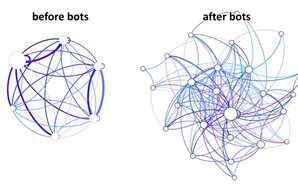
Algorithmification & Social Complexity:
- Hilbert, M., & Darmon, D. (2020). Large-Scale Communication is More Complex and Unpredictable with Automated Bots. Journal of Communication. https://doi.org/10.1093/joc/jqaa021
- Hilbert, M., & Darmon, D. (2020). How Complexity and Uncertainty Grew with Algorithmic Trading. Entropy, 22(5), 499. https://doi.org/10.3390/e22050499
Gil Lopez, T., Shen, C., Benefield, G., Palomares, N., Kosinski, M. & Stillwell, D. (2018). One Size Fits All: Context Collapse, Self-Presentation Strategies and Language Styles on Facebook. Journal of Computer-Mediated Communication, 23(3), 127-145.
- ABSTRACT: This study empirically examines context collapse on Facebook by examining audience influences on content and language in self-disclosures. Context collapse is the process of disparate audiences being conjoined into one. Using a public longitudinal behavioral data set of 6,378 Facebook users, the study found that the size and heterogeneity of people’s networks were positively associated with the number of text status updates they posted, but negatively associated with language style variability of these updates during 12 months. Results suggest that people manage their online self-presentation in ways that are consistent with lowest common denominator, imagined audience, and accommodation propositions. Network size was positively associated with the proportion of positive emotional language and negatively with negative emotional language, whereas heterogeneity had the opposite effect. https://academic.oup.com/jcmc/article/23/3/127/4962540
Big Data for the United Nations (work done with (former) students from the C^2 lab):
- UN ECLAC (United Nations Economic Commission for Latin America and the Caribbean). (2020). Tracking the digital footprint in Latin America and the Caribbean: Lessons learned from using big data to assess the digital economy (Productive Development, Gender Affairs LC/TS.2020/12; Documentos de Proyecto). United Nations ECLAC. https://repositorio.cepal.org/handle/11362/45484
- Hilbert, M., & Lu, K. (2020). The online job market trace in Latin America and the Caribbean (UN ECLAC LC/TS.2020/83; p. 79). United Nations Economic Commission for Latin America and the Caribbean. https://www.cepal.org/en/publications/45892-online-job-market-trace-latin-america-and-caribbean
- Hilbert, M., Khai Bach, J., Bomactao, R., Dou, J., Duong, J., Escobar, J., ... Zhang, H. P. (2018). Digital Footprints from Latin America and the Caribbean / Huellas digitales de América Latina y el Caribe (SSRN Scholarly Paper No. ID 3162864). https://papers.ssrn.com/abstract=3162864
Frey, S., Goldstone, R. L. (2018) Cognitive mechanisms for human flocking dynamics. Journal of Computational Social Science, 1(2), 349–375.
- ABSTRACT: Low-level "adaptive" and higher-level "sophisticated" human reasoning processes have been proposed to play opposing roles in the emergence of unpredictable collective behaviors such as crowd panics, traffic jams, and market bubbles. While adaptive processes are widely recognized drivers of emergent social complexity, complementary theories of sophistication predict that incentives, education, and other inducements to rationality will suppress it. We show in a series of multiplayer laboratory experiments that, rather than suppressing complex social dynamics, sophisticated reasoning processes can drive them. Our experiments elicit an endogenous collective behavior and show that it is driven by the human ability to recursively anticipate the reasoning of others. We identify this behavior, ``sophisticated flocking'', across three games, the Beauty Contest and the "Mod Game" and "Runway Game". In supporting our argument, we also present evidence for mental models and social norms constraining how players express their higher-level reasoning abilities. By implicating sophisticated recursive reasoning in the kind of complex dynamic that it has been predicted to suppress, we support interdisciplinary perspectives that emergent complexity is typical of even the most intelligent populations and carefully designed social systems. https://arxiv.org/abs/1506.05410
Hilbert, M., Ahmed, S., Cho, J., Liu, B., & Luu, J. (2018). Communicating with Algorithms: A Transfer Entropy Analysis of Emotions-based Escapes from Online Echo Chambers. Communication Methods and Measures, 0(0), 1–16.
- ABSTRACT: Online algorithms have received much blame for polarizing emotions during the 2016 U.S. presidential election. We use transfer entropy to measure directed information flows from human emotions to YouTube’s video recommendation engine, and back, from recommended videos to users’ emotions. We find that algorithmic recommendations communicate a statistically significant amount of positive and negative affect to humans. Joy is prevalent in emotional polarization, while sadness and fear play significant roles in emotional convergence. These findings can help to design more socially responsible algorithms by starting to focus on the emotional content of algorithmic recommendations. Employing a computational-experimental mixed method approach, the study serves as a demonstration of how the mathematical theory of communication can be used both to quantify human-machine communication, and to test hypotheses in the social sciences. https://www.martinhilbert.net/communicating-with-algorithms/
Zhang, J., Calabrese, C., Ding, J., Liu, M., & Zhang, B. (2018). Advantages and challenges in using mobile apps for field experiments: A systematic review and a case study. Mobile Media & Communication, 6(2), 179-196.
- ABSTRACT: As smartphone’s computing power continues to grow and as mobile applications (apps) continue to dominate digital engagement, apps have become a new frontier for advancing field experiment methodology. Using apps may help researchers to scale up the reach, precisely control randomization and experiment materials, collect a variety of objective and self-reported data over time, and more conveniently replicate and adapt an experiment. We performed a systematic review on field experiments involving apps published between 2007 and 2017. Seven databases were scanned using a predefined search strategy. The database search retrieved 4,810 citations; 101 articles met the inclusion criteria. Our review suggests that scholars have only started to employ apps in field experiments in the last 4 years. Most studies only used apps as an experiment treatment instead of an experiment platform; therefore, researchers have yet to fully leverage the advantages. Almost all studies were from the health research domain and 77.2% used randomized controlled trial design. Only 7 studies utilized smartphone sensors for collecting data. Only one study reported cost and ethical concerns regarding using apps for the experiment. Given these findings, we reported a case study that targeted a minority racial group and leveraged the advantages of apps as an experiment platform and as a data collection tool to illustrate practical challenges and lessons learned regarding time, financial cost, and technical support. In conclusion, we suggest apps provide new ways to study causal mechanisms with experiment big data. Limitations of generalizability, retention, and design quality were discussed as well. http://journals.sagepub.com/doi/10.1177/2050157917725550
Barnett, G. A., Xu, W. W., Chu, J., Jiang, K., Huh, C., Park, J. Y., & Park, H. W. (2017). Measuring international relations in social media conversations. Government Information Quarterly, 34(1), 37-44.
- ABSTRACT: This paper examines international relations as perceived by the public in their social media conversations. It examines over 1.8 billion Facebook postings in English and 51 million Chinese posts on Weibo, to reveal the relations among nations as expressed in social media conversations. It argues that social media represent a transnational electronic public sphere, in which public discussions reveal characteristics of international relations as perceived by a foreign public. The findings show that the international relations in social media postings match the core-peripheral structure proposed in the World Systems Theory. Additionally, the relations are associated with the amount of news coverage and public attention a country receives. Overall, the study demonstrates the value of webometric data in revealing how international relations are perceived by average citizens. https://cloudfront.escholarship.org/dist/prd/content/qt0qv7x3gk/qt0qv7x3gk.pdf
Jaidka, K., Ahmed, S., Skoric, M., & Hilbert, M. (2018). Predicting elections from social media: a three-country, three-method comparative study. Asian Journal of Communication, 0(0), 1–21. https://doi.org/10.1080/01292986.2018.1453849
- ABSTRACT: This study introduces and evaluates the robustness of different volumetric, sentiment, and social network approaches to predict the elections in three Asian countries – Malaysia, India, and Pakistan from Twitter posts. We find that predictive power of social media performs well for India and Pakistan but is not effective for Malaysia. Overall, we find that it is useful to consider the recency of Twitter posts while using it to predict a real outcome, such as an election result. Sentiment information mined using machine learning models was the most accurate predictor of election outcomes. Social network information is stable despite sudden surges in political discussions, for e.g. around elections-related news events. Methods combining sentiment and volume information, or sentiment and social network information, are effective at predicting smaller vote shares, for e.g. vote shares in the case of independent candidates and regional parties. We conclude with a detailed discussion on the caveats of social media analysis for predicting real-world outcomes and recommendations for future work. https://www.martinhilbert.net/predicting-elections-from-social-media/

Cuihua Shen, Rabindra Ratan, Y Dora Cai, Alex Leavitt (2016). Do men advance faster than women? Debunking the gender performance gap in two massively multiplayer online games. Journal of Computer-Mediated Communication, 21(4), 312–329.
- ABSTRACT: Prior research on digital games illustrates a perceived gender gap in participation and performance, suggesting men as playing more and better than women. This article challenges the gender gap using longitudinal behavioral data of men and women in 2 MMOs in the United States and China. Results show that women advance at least as fast as men do in both games. Thus, perceived gender-based performance disparities seem to result from factors that are confounded with gender (i.e., amount of play), not player gender itself. We conclude that the stereotype of female players as inferior is not only false, but also a potential cause for unequal participation in digital gaming. Summary article: The Conversation, Debunking one of the biggest stereotypes about women in the gaming community
- ABSTRACT: In our information age, information alone has become a driver of social growth. Information is the fuel of “big data” companies, and the decision-making compass of policy makers. Can we quantify how much information leads to how much social growth potential? Information theory is used to show that information (in bits) is effectively a quantifiable ingredient of growth. The article presents a single equation that allows both to describe hands-off natural selection of evolving populations and to optimize population fitness in uncertain environments through intervention. The setup analyzes the communication channel between the growing population and its uncertain environment. The role of information in population growth can be thought of as the optimization of information flow over this (more or less) noisy channel. Optimized growth implies that the population absorbs all communicated environmental structure during evolutionary updating (measured by their mutual information). This is achieved by endogenously adjusting the population structure to the exogenous environmental pattern (through bet-hedging/portfolio management). The setup can be applied to decompose the growth of any discrete population in stationary, stochastic environments (economic, cultural, or biological). Two empirical examples from the information economy reveal inherent trade-offs among the involved information quantities during growth optimization.
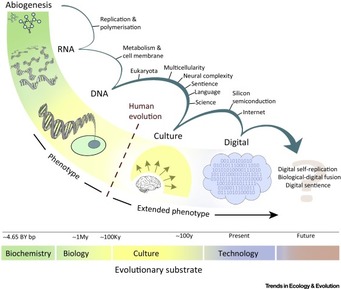
Gillings, M. R., Hilbert, M., & Kemp, D. J. (2016). Information in the Biosphere: Biological and Digital Worlds. Trends in Ecology & Evolution, 31(3), 180–189. (Journal Site / Full Article)
- ABSTRACT: Evolution has transformed life through key innovations in information storage and replication, including RNA, DNA, multicellularity, and culture and language. We argue that the carbon-based biosphere has generated a cognitive system (humans) capable of creating technology that will result in a comparable evolutionary transition. Digital information has reached a similar magnitude to information in the biosphere. It increases exponentially, exhibits high-fidelity replication, evolves through differential fitness, is expressed through artificial intelligence (AI), and has facility for virtually limitless recombination. Like previous evolutionary transitions, the potential symbiosis between biological and digital information will reach a critical point where these codes could compete via natural selection. Alternatively, this fusion could create a higher-level superorganism employing a low-conflict division of labor in performing informational tasks.
- ABSTRACT: We examined the relationship between social capital, coplaying patterns and health disruptions in a large sample of gamers in a popular Chinese Massively Multiplayer Online Game, Chevaliers’ Romance 3. Partnering with the game operator, we fielded an online survey (N = 18813) in 2011. Social capital was measured by (1) psychometric measures of bridging and bonding social capital, and (2) core discussion network size using name generators, as well as the number of strong and weak ties within the core network. Controlling for sociodemographic variables, we found that bonding social capital was associated with lower odds of frequent or occasional health disruptions, but bridging social capital did not have any effect. Weak ties in the core network were associated with greater odds of health disruptions. Coplaying patterns also mattered – people playing with friends first met through CR3 were less likely to have health disruptions, while playing with existing friends and families tended to have the opposite effect. Overall, social capital and coplaying patterns appear to have significant health implications for participants in online games.
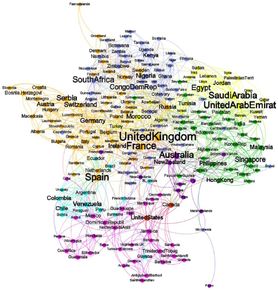
Barnett, G. A., & Benefield, G. A. (2015). Predicting international Facebook ties through cultural homophily and other factors. New Media & Society, 1461444815604421. (Journal Site)
- ABSTRACT: This study describes the structure of the international Facebook friendship network and its determinants using various predictors, including physical proximity, cultural homophily, and communication. Network analysis resulted in one group of nations, with countries that bridge geographic and linguistic clusters (France, Spain, United Kingdom, and United Arab Emirates) being the most central. Countries with international Facebook friendship ties tended to share borders, language, civilization, and migration. Physical distance, shared hyperlinks, use of common websites, telephone traffic, cultural similarity, and international student exchange were either weakly or not significantly related to international Facebook friendships.
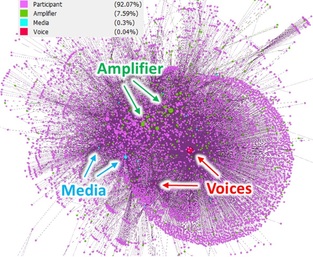
Hilbert, M., Vásquez, J., Halpern, D., Valenzuela, S., & Arriagada, E. (2016). One-step, two-step, network-step? Complementary perspectives on communication flows in Twittered citizen protests. Social Science Computer Review.
- ABSTRACT: The article analyzes the nature of communication flows during social conflicts via the digital platform Twitter. We gathered over 150,000 Tweets from citizen protests for nine environmental social movements in Chile, and use a mixed-methods approach to show that longstanding paradigms for social mobilization and participation are neither replicated nor replaced, but reshaped. In digital platforms, long standing communication theories, like the 1955 two-step flow model, are still valid, while direct one-step flows and more complex network flows are also present. For example, we show that it is no contradiction that participants mainly refer to intermediating amplifiers (39 % of the mentions from participants go through this two-step flow), while at the same time traditional media outlets and official protest voices receive 80-90 % of their mentions directly through a direct one-step flow from the same participants. While non-intuitive at first sight, Bayes’ theorem allows to detangle the different perspectives in the arising communication channel. We identify the strategic importance of a group of amplifying intermediaries in local positions of the networks, who coexist with specialized voices and professional media outlets at the center of the global network. We also show that direct personalized messages represent merely 20 % of the total communication. This shows that the fine-grained digital footprint from social media enable us to go beyond simplistic views of a single all-encompassing step-flow model for social communication. The resulting research agenda builds on longstanding theories with a new set of tools.

Shen, C. & Cage, C. (2015). Exodus to the Real World? Assessing the Impact of Offline Meetups on Community Participation and Social Capital. New Media & Society, 17(3), 394-414. (Full Article / Journal Site)
- ABSTRACT: Despite the increasing popularity of offline “meetups” among online community participants, little is known about their effect on the health and function of these communities. Using longitudinal network data of both public and private communications among participants of an online community for science fiction fans, this study represents one of the first systematic assessments of the impact of meetups on community participation and members’ bridging and bonding social capital. Results showed that meetups would enhance attendees’ bonding social capital, but that increase would come at the expense of bridging social capital, reducing the opportunity for new members to join and find acceptance in the community. The effect of meetup on community participation was mixed.
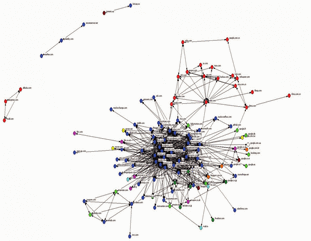
Barnett, G. A., Ruiz, J. B., & Park, H. W. (2015). Globalization or Decentralization of Hyperlinked Content among Websites: An Examination of Website Co-citations. In 2015 48th Hawaii International Conference on System Sciences (HICSS) (pp. 1779–1787). (Journal Site)
- ABSTRACT: Hyperlink network analysis has provided an important framework for understanding the structure of the Internet/WWW. However, the inclusion of other measures provides additional information about the structure of the web. This research presents still another approach to describe the structure of the Internet/WWW by assessing the network of websites' domains based on their co-citations with other websites. Results indicate that a group of websites from the United States is at the network's center. YouTube, Facebook, Twitter, Google, Instagram, and Blogspot had the greatest degree centralities. Google was highest in betweenness centrality. A cluster analysis revealed three distinct groups of websites, American, Chinese and pornographic. Future research should assess content type and language's role in network structure.
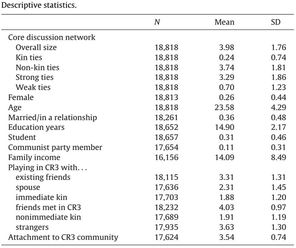
Shen, C. & Chen, W. (2015). Gamers’ Confidants: Massively Multiplayer Online Game participation and core networks in China. Social Networks, 40, 207-214. (Full Article / Journal Site)
- ABSTRACT: Through a survey of more than 18,000 participants in a Chinese Massively Multiplayer Online Game (MMOG), this study examines how the size and diversity of Chinese gamers’ core networks vary by individuals’ sociodemographic, socioeconomic and game-related characteristics. It represents the first study focusing exclusively on the gamer population and one of the most recent examining personal networks in contemporary China, home to over 560 million Internet users. We found that Chinese gamers have notably larger and more diverse core networks than those of major studies. Coplaying patterns and attachment to the game community contributed significantly to network size and diversity.
